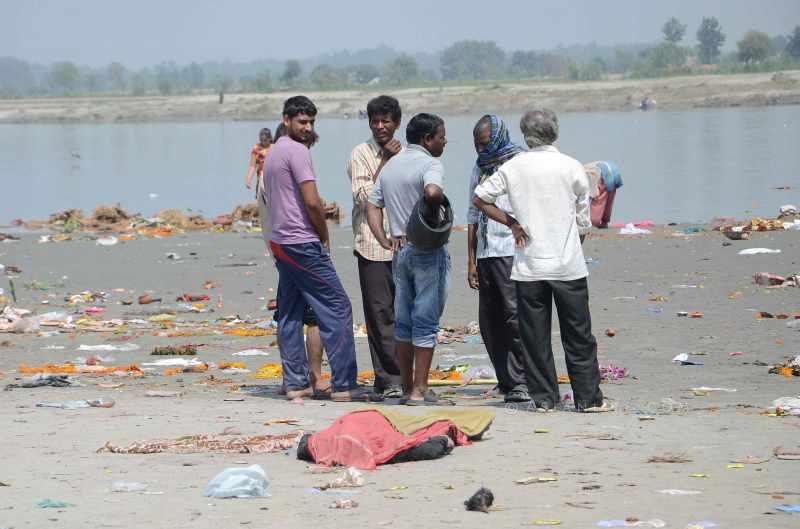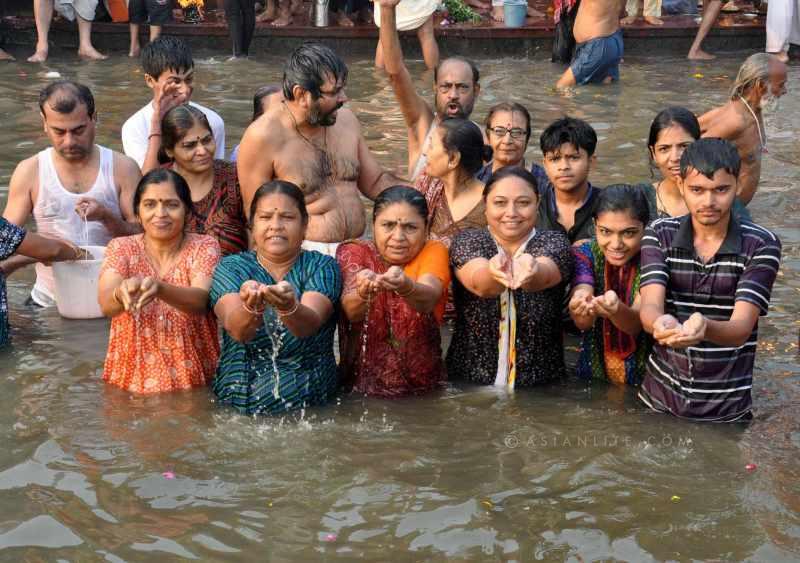Brij Khandelwal visits Mathura/Vrindavan/Agra to file a report on the holy river Yamuna. He says in Krishna’s land, ‘holy’ Yamuna is a sickly drain.
 Every day, thousands of devout Vaishnavs from all over the world return disappointed and frustrated from the ghats in Braj mandal, the land of Sri Krishna-Radha, when they see the miserable condition of the Yamuna river, stinking and rotting with pollutants, dead fish and toxins flowing down from upstream industrial clusters in Delhi and Haryana.
Every day, thousands of devout Vaishnavs from all over the world return disappointed and frustrated from the ghats in Braj mandal, the land of Sri Krishna-Radha, when they see the miserable condition of the Yamuna river, stinking and rotting with pollutants, dead fish and toxins flowing down from upstream industrial clusters in Delhi and Haryana.
Most go to take a holy dip or ‘aachman’ of the Yamuna, one of the holiest rivers of the Hindus, but the water of the river, which once Babar, the founder of the Mughal empire, described as “better than nectar” fills them with disgust, says Acharya Madhukar Chaturvedi, a Haveli Sangeet specialist.
The ghats along the banks of the river are buried in polluted silt. In Vrindavan, the Yamuna today flows at least 30 metres away from the famous Keshi Ghat.
“Without water in the river, devotees who will throng the river on Ganga Dussehra (June 8) will only feel hurt and cheated. Water should be released from upstream barrages,” demand Vrindavan’s Maheshanand Saraswati, Shambhu Charan Shukla and other saints. (Ganga Dussehra celebrates the descent of the river to earth).
Some Yamuna devotees and environmental groups have of late begun cleaning up the ghats in Mathura and Vrindavan. The plan is to scoop out earth and create ponds at the ghats for the pilgrims, says Jagan Nath Poddar, convener of the Friends of Vrindavan NGO.
 “But without a minimum flow, particularly during the lean months, it is not possible to revive the river or to restore its past glory. Encroachments in the form of concrete structures on both sides are another major problem. With better road connectivity, the number of pilgrim-tourists has increased manyfold. On weekends, lakhs (hundreds of thousands) turn up for a darshan of Bankey Bihari in Vrindavan and a parikrama of the holy Goverdhan hill. When these people go to the Yamuna, the reaction is sharp and negative. One hears only curses and abuses,” Poddar told IANS.
“But without a minimum flow, particularly during the lean months, it is not possible to revive the river or to restore its past glory. Encroachments in the form of concrete structures on both sides are another major problem. With better road connectivity, the number of pilgrim-tourists has increased manyfold. On weekends, lakhs (hundreds of thousands) turn up for a darshan of Bankey Bihari in Vrindavan and a parikrama of the holy Goverdhan hill. When these people go to the Yamuna, the reaction is sharp and negative. One hears only curses and abuses,” Poddar told IANS.
In Mathura, the polluted effluents from hundreds of sari-dyeing units discharged in the river have only compounded the problem. After the construction of the Gokul Barrage, the river has distanced itself from the historical Gokul ghats. This obviously causes deep resentment and angry outbursts.
“The water is not fit for a holy dip or aachman. Those who dare to enter the Yamuna downstream of Gokul Barrage return complaining of an itching and burning sensation,” according to a panda of Mahavan Radhey Guru.
Reduced to a pale, sickly drain, the glory and grandeur of the Yamuna that attracted the Mughals to build some of the finest monuments like the Taj and Etmaduddaula along its banks will never return, lament the residents of the Yamuna Kinara road in Agra.
While the younger folk have generally stayed away from the stinking river which holds no charm for them, people of the older generations do occasionally venture out to conduct ritualistic pujas and baths. The dozen-odd ghats along the riverfront, which once was the centre of a thriving commercial activity and river culture, have disappeared without a trace, reducing the 10-km-long riverfront to a vast wasteland.
From the Kailash temple to the Dussehra Ghat adjacent to the Taj, there were more than a score of permanent ghats, some of red sandstone and others of marble. Behind the Red Fort there were permanent ghats with highly decorative canopies for the royal females of the Mughals.
Some ghats fell prey to man’s indifference, others were razed to the ground by zealous bureaucrats on the late Sanjay Gandhi’s orders during the emergency to make way for a “picturesque” river front like Mumbai’s Chowpati. But before that dream could materialise, politics took a U-turn and Indira Gandhi was swept out of power in the 1977 general elections after the emergency was lifted.
Today, the river of decadence is an eyesore. Those who take the Yamuna Kinara road are often seen covering their noses to keep away the foul odour of the stinking mess.
Goswami Hari Mohan Shrotriya of the Sri Mathuradheesh temple lamented: “Those were the days when the citizens of Agra used to spend leisurely summer evenings on the river bank, which had a long row of temples. Children used to feed the tortoises and a whole lot of cultural and religious activities used to be held here. But now the people have turned away and have even forgotten there’s a river in the city.”
Hathi Ghat near the fort still survives but the entire area has been rampaged by transport companies, whose vehicles are parked there. Nathi Lal of Katcheri Ghat warned: “if the ghats disappear, the river culture, the annual melas and tamashas, the tairaki (swimming contests), patangbazi and the mass bathing programmes on festivals would vanish too.”
Citizens groups like India Rising have been exerting pressure on the government agencies to take up cleanliness drives, build permanent ghats and dredge out silt from the riverbed to hold back the monsoon overflow, but so far there has been no positive response.
But with Narendra Modi becoming the prime minister and Uma Bharti leading the Ganga cleaning campaign, hopes have once again been revived of some action at the government level to restore the glory of the Yamuna in the Braj area.
The Braj Mandal Heritage Conservation Society has in a memorandum to the prime minister urged him to replicate the Sabarmati model in Agra and Mathura. “The Sabarmati river in Ahmedabad was reduced to a dirty drain, but the Modi government carried out structural changes and the success is there for all to see,” society president Surendra Sharma said.
Citizens groups have also sent a memorandum to President Pranab Mukherjee to request involvement and cooperation of the armed forces in what they call “Operation rivers of India clean-up”, Colonel (retd) Sudershan Dua told IANS, adding: “The forces have trained manpower and heavy equipment. Each army cantonment can take care of the stretch as in Mathura and Agra, providing backup services to environmental groups to clean up the ghats and scoop out pollutants. Already a situation has been created that calls for a war against river pollution.”